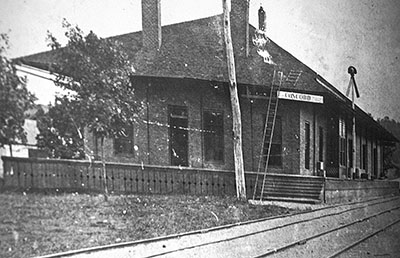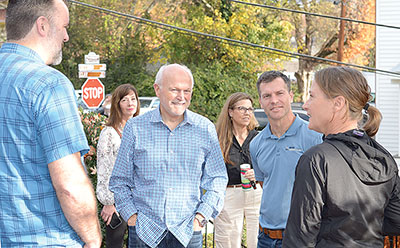Re-living Old Concord at FWKCC Breakfast Speaker Series
Old Concord, once a thriving community sustained by the pink marble quarry and the railroad, now stands as a quiet place off Concord Road.
Local residents, such as Ralph Henry who works with Concord Presbyterian Church, still remember where the pool was located in Concord.
Farragut West Knox Chamber of Commerce took its members and local residents on a tour and a look back the community’s history during its Breakfast Speaker Series, “A Walk Through Time — Concord’s Past, West Knox’s Future” — Thursday morning, Nov. 7, in Concord Presbyterian Church, 11000 Second St. There, they heard from columnist Sam Venable and historian Jack Neely, then took a tour led by Realtor Jennifer Montgomery.
Concord’s history began with Adm. David Glasgow Farragut’s father back in the late 18th century. He was a Spanish immigrant who once ran a ferry in Concord. The history trail continued with his son, who became the U.S. Navy’s first commissioned admiral at just 9 years old. His famous command from his Civil War battle days was: “Damn the torpedoes. Full steam ahead!”
Farragut High School and Town of Farragut are named in his honor.
“I’ve been (coming) to Concord as long as I can remember,” said Neely, executive director of the Knoxville History Project. “As long as I can remember, in my 60 years, we came here a lot.
“We came here on Sunday afternoons, had a picnic by the water,” he added. “I remember hearing the word Concord; you could smell the lake. It was an exciting thing for a kid to come out here.”
He also remembered the public swimming pool.
“There weren’t many public swimming pools in Knoxville,” Neely said.
He also remembered a YMCA day camp in the area. At times, he would look across the inlet and see “the little fairy tale town” of Concord.
“I’d wonder about it,” he said.
The community started as an agricultural hub, according to Neely.
However, its growth started in the latter 1830s with the addition of the railroad and when Thomas Calloway built a railroad station in Concord. Cumberland Presbyterian Church, built in the 1700s, already was a fixture. Neely said the community, though, was named Concord because it was seen as an “ideal.”
By 1855, Knoxville then was an industrial city — and Concord got its first post office. Shortly afterward, the Civil War began, slowing the community’s growth, but “things picked up again in 1869,” Neely said.
At that time, there were 400 people living in Concord and it “had a railway station that was different from other rural communities,” he added.
The quarry in 1883 was then on an industrial scale. But Concord remained an agricultural center in the early 1880s, Neely said. The community had a fairgrounds, bank, post office and racetrack.
According to Neely, three things changed Concord’s history: • The Dixie Highway (now Highway 11/Kingston Pike in Farragut) — running from Michigan to Florida — was built in the 1920s. “It sucked the energy away from the railroad,” on which Concord depended; • The bottom fell out of the marble industry because of the Modernist era, also in the 1920s; and • TVA flooded most of Concord (Fort Loudoun Lake) in the 1930s.




